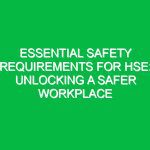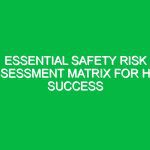Welcome to the Toolbox Talk
Hello everyone, and thank you for joining today’s Toolbox Talk. The purpose of our discussion today is to dive deep into the critical topic of COVID-19 Cleaning & Decontamination within the Health, Safety, and Environment (HSE) framework. As we all know, ensuring a safe and healthy workplace is more important than ever, especially in the context of ongoing concerns surrounding COVID-19. Today, we will explore essential cleaning practices, discuss Procedures, and highlight the importance of our collective responsibility in maintaining a safe working environment.
Understanding COVID-19 Cleaning & Decontamination
Before we get into the specifics, let’s clarify what we mean by COVID-19 Cleaning & Decontamination. Cleaning refers to the physical removal of dirt, germs, and impurities from surfaces, while decontamination is the process of making a surface safe by eliminating or neutralizing harmful pathogens. These processes are crucial in preventing the spread of COVID-19 and other infectious diseases in our workplace.
The Importance of COVID-19 Cleaning & Decontamination
COVID-19 can spread through respiratory droplets and contaminated surfaces, making thorough cleaning and decontamination vital. By implementing effective cleaning protocols, we can:
- Reduce Transmission: Regular cleaning minimizes the chances of virus transmission among employees.
- Protect Vulnerable Individuals: Some coworkers may be at higher risk due to health conditions; protecting them is essential.
- Comply with Regulations: Adhering to guidelines set by health authorities and the government ensures we meet legal obligations.
- Enhance Workplace Morale: A clean environment promotes a sense of Safety and well-being among employees.
Key Components of COVID-19 Cleaning & Decontamination
Let’s break down the key components of effective COVID-19 Cleaning & Decontamination:
1. Identify High-Touch Surfaces
High-touch surfaces are areas that are frequently touched by multiple people. Examples include:
- Door handles
- Light switches
- Shared equipment
- Desks and workstations
- Restroom faucets
Regularly prioritizing the cleaning of these surfaces will significantly reduce the risk of exposure.
2. Select Appropriate Cleaning Agents
It’s essential to use cleaning agents that are effective against the COVID-19 virus. Look for products that:
- Are approved by health authorities like the EPA (Environmental Protection Agency)
- Contain at least 70% alcohol or equivalent disinfectants
Always read the label for proper usage instructions to ensure effectiveness.
3. Develop a Cleaning Schedule
Consistency is key. Create a cleaning schedule that outlines:
- Frequency of cleaning (e.g., daily, weekly)
- Specific areas to be cleaned
- Who is responsible for cleaning tasks
Communicate this schedule to all team members to ensure accountability.
4. Implement Proper Techniques
When cleaning and disinfecting, follow these Best Practices:
- Wear Personal Protective Equipment (PPE) such as gloves and masks.
- Clean surfaces with soap and water before applying disinfectants.
- Use disposable cloths or paper towels for cleaning and disinfecting.
- Allow disinfectants to remain on surfaces for the recommended contact time.
Real-Life Scenarios
Let’s visualize a couple of scenarios to understand the importance of our discussion better:
Scenario 1: Office Workspace
Imagine you’re in the office, and you notice that the shared printer is being used frequently by multiple employees. If we neglect to clean it regularly, it could become a hotspot for virus transmission. By establishing a routine cleaning schedule for the printer and ensuring that it is disinfected after each use, we can minimize this risk.
Scenario 2: Break Room
In another situation, consider the break room where employees gather for meals. The tables, microwave, and refrigerator handles are often overlooked. If we implement a cleaning protocol for this area and encourage everyone to clean up after themselves, we create a safer environment for all.
Potential Hazards and Safety Considerations
While cleaning and disinfecting, it’s crucial to be aware of potential Hazards:
- Chemical Exposure: Some cleaning agents can be harmful if inhaled or if they come into contact with skin. Always use PPE and follow safety data sheets.
- Slips and Falls: Wet surfaces due to cleaning can pose a risk. Use signage to alert others to wet floors.
Best Practices for COVID-19 Cleaning & Decontamination
To enhance our cleaning efforts, consider these Best Practices:
- Incorporate a “clean as you go” policy where employees are encouraged to clean their work areas regularly.
- Host Training sessions on proper cleaning techniques and the importance of compliance.
- Keep cleaning supplies readily available and easily accessible throughout the workplace.
Regulations and Standards
Compliance with relevant regulations is essential for safety and legal obligations. Familiarize yourself with:
- OSHA (Occupational Safety and Health Administration) guidelines
- CDC (Centers for Disease Control and Prevention) recommendations
- Local health department mandates
Adhering to these guidelines not only ensures our safety but also protects our company from potential liabilities.
Discussion and Engagement
As we wrap up today’s Toolbox Talk on COVID-19 Cleaning & Decontamination, I encourage everyone to share their thoughts. Here are some questions to spark discussion:
- What challenges have you faced in maintaining cleanliness at your workstations?
- Are there additional cleaning practices we should consider implementing?
- How can we encourage all team members to take responsibility for cleanliness?
Conclusion
Today, we’ve covered the essentials of COVID-19 Cleaning & Decontamination, emphasizing its importance in creating a safe workplace. Remember, each of us plays a vital role in this effort. By following the practices we discussed, we can contribute to a healthier environment for ourselves and our coworkers. Thank you for your attention and commitment to safety. Let’s work together to ensure our workplace remains safe and healthy for everyone!


